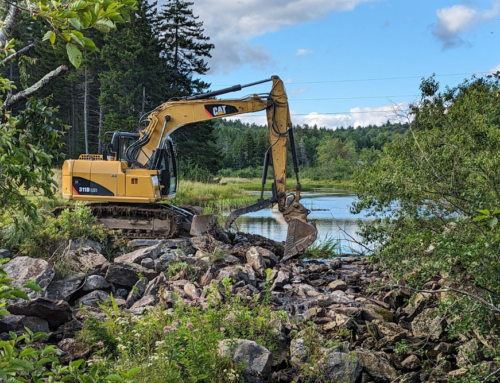Sometimes you are just doing your job when some unexpected wild things happen to you.
When you work to protect a river you can look at all the concerns, ideas to address the concerns, paper plans and engineering designs you want to, but if you are going to truly work with a river you have to go to the river. It is on river where studies and plans are put to the test.
On this day representatives of stakeholders involved in the Fifteen Mile Falls (FMF) hydro relicensing settlement were headed onto the reach of river between Comerford Dam and the confluence of the main river with the Passumpsic River. Comerford dam is one of the three dams in the FMF complex. FMF is the largest single hydro power project in New England and during the relicensing process the owner agreed to put structures in place below Comerford to create refuge from high flow releases from the dam.
The structures would be made of large boulder clusters placed in the river so fish and other aquatic species would not be swept away or have to expend large amounts of energy to stay in place when the dam generated power. We were all on the way to the river to help the consultants and permitting agencies design the size, shape and location of the boulder clusters. That in itself was rewarding enough because this was another step forward in improving the health of this reach of river. But then the wildlife started strutting their stuff for us.
As we drove into the location a flock of wild turkeys made up of several adult female birds and a large clutch of babies went scampering across a field. All looked well with this flock of baby birds – except of course they wanted nothing at all to do with us.
When we got to the river, the water flow from the dam had been lowered as planned by agreement with TransCanada Hydro Northeast and the permitting agencies to allow us to do our work. The low flow stimulated the insect life and because of that the fish were rising all along the reach of river, most of them trout. Many of us regretted not bringing our fly rods but this was a work assignment, so it was just as well we did not have them with us.
At the work site two people began wading across the river to check on the depth of the river in certain locations. Others were on the shore looking at preliminary design plans and discussing options. Down river from where we were working there was a rapid fully exposed due to the lowered river level. An osprey flew up river toward us and when it reached the rapids it flew slowly over different parts of the rapids for a while checking here and there until it hovered in place and then dove out of the sky and snagged a fish.
Those of us who saw this yelled to the others and we all watched as the osprey struggled an inordinately long time to secure the fish. While getting the fish under control it tried mightily to stay out of the water by beating its wings and thrashing the water. Finally as it started to fly away it was clear that it had snagged an outsized fish and it was having trouble even getting airborne. By the time the bird reached the far side of the river the fish proved too much and the osprey was forced to drop it. The osprey disappeared for a while but came back and hovered over the same spot in the rapids where it had snagged that fish. Eventually realizing there was no fish there it flew off to hunt elsewhere.
With no further distractions by nature we went ahead and finished our onsite work and headed home. As we drove out the farm road a female deer jumped out of the bushes and ran across the road. The driver stopped to let her pass and we were glad we stopped to watch her because a split second after the mother had made the safety of the woods a small speckled fawn, no bigger than a fox came scampering across the road chasing mommy. When both fawn and mother were safety in the shelter of the woods we continued on our way.
We thought this has been quite a day but nature had one last surprise sighting for us. As we reached the main road, off in the back of a field a moose was moving lazily toward the edge of the woods. It was a young moose but it had started to grow antlers. It was not terribly concerned about us but when it entered the woods we were on our way.
There are good days and there are great days, this was a great day. We had been working all morning to help the Connecticut River making it a good day but the close observations of wild nature one incident after another made it a great day.
David Deen is River Steward for the Connecticut River Watershed Council. CRC has been a protector of the Connecticut River for more than half a century.







